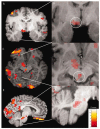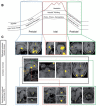Imaging the Premonitory Phase of Migraine
- PMID: 32269547
- PMCID: PMC7109292
- DOI: 10.3389/fneur.2020.00140
Imaging the Premonitory Phase of Migraine
Abstract
Migraine is a common and disabling brain disorder with a broad and heterogeneous phenotype, involving both pain and painless symptoms. Over recent years, more clinical and research attention has been focused toward the premonitory phase of the migraine attack, which can start up to days before the onset of head pain. This early phase can involve symptomatology, such as cognitive and mood change, yawning, thirst and urinary frequency and sensory sensitivities, such as photophobia and phonophobia. In some patients, these symptoms can warn of an impending headache and therefore offer novel neurobiological insights and therapeutic potential. As well as characterization of the phenotype of this phase, recent studies have attempted to image this early phase using functional neuroimaging and tried to understand how the symptoms are mediated, how a migraine attack may be initiated, and how nociception may follow thereafter. This review will summarize the recent and evolving findings in this field and hypothesize a mechanism of subcortical and diencephalic brain activation during the start of the attack, including that of basal ganglia, hypothalamus, and thalamus prior to headache, which causes a top-down effect on brainstem structures involved in trigeminovascular nociception, leading ultimately to headache.
Keywords: headache; migraine; neuroimaging; premonitory; prodrome.
Copyright © 2020 Karsan and Goadsby.
Figures


References
-
- Gowers W. A Manual of Diseases of the Nervous System. 3rd ed Philadelphia: P. Blakiston, Son & Co; (1899).
Publication types
Grants and funding
LinkOut - more resources
Full Text Sources
Research Materials

